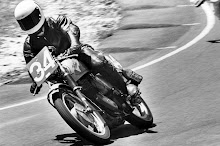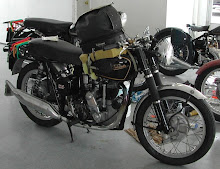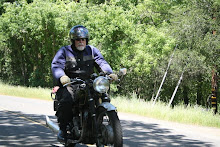
Compact and trim, immensely appealing in its simplicity of layout and construction, the forlorn little overhead-camshaft 250 cc engine looks as though it might have the makings of a real winner and no doubt when the first pencil strokes of its design were committed to paper, it seemed more promising still.
Veloce Ltd., the makers concerned were well-respected for their ohv three-fifties and five-hundreds, but there was a definite need for a sporty two-fifty in the range. Why, they might have even consider re-entering the racing field with it; in a modest sort of way.
Bertie Goodman recalled: “Some time in 1960 – we had a policy meeting at which my uncle Eugene (managing director at that time) and I, as sales director, discussed several ideas for future models.”
“One thought was for a new design of five-hundred, but I felt that we should go for a unit-construction two-fifty, and that was the type on which we settled.”
design of five-hundred, but I felt that we should go for a unit-construction two-fifty, and that was the type on which we settled.”
There has been 250 cc Velocettes before, notably the GTP two-stroke with throttle-controlled pump lubrication, and the push-rod MOV model from which the Viper and Venom had descended.
But the newcomer was a complete break with Hall Green tradition in that it was to have a single overhead camshaft driven by chain.
“We had in mind an engine to power a reasonably-priced touring bike,” continued Bertie, “yet capable of being developed at moderate cost into a useful racing unit.
To keep the selling price down, the bike would have the Viper front fork and wheel, and as many other standard components as could be used.”
 “Charles Udall was our chief designer – this was just before he left us, to join AMC in Woolwich – and the drawing-office work was done under his direction by George Wilkes.”
“Charles Udall was our chief designer – this was just before he left us, to join AMC in Woolwich – and the drawing-office work was done under his direction by George Wilkes.”
“At first, we hoped to cut costs by making use of the then-new Royal Enfield five-speed gear cluster. But Enfield refused to play ball so, instead, we talked with the Ariel company – and with Burman, who made the Ariel assembly – for permission to get supplies of the internals of the Ariel Leader gear box.”
“They agreed, and if you study the engine as it now stands, you will see that the gear-box shell – though the machining of it was never finished – was intended to accept the Ariel bits.
“I forget the actual dimensions we decided on, but it would almost be certainly have been square – 68 x 68mm bore and stroke rings a bell somewhere. There should have been a standard British Hub rear wheel.”
The dualseat, mud-guards and electrics were to be brought-out items, so we would not have had to produce many parts of the bike in our own works.
As for the projected road-racing programme, you have to remember that around this time a machine such as the OHC NSU single was still competitive.
The Japanese onslaught was a bit in the future, and we would have stood quite a reasonable chance with an engine turning out 30 bhp or thereabouts.
For racing we would have had to use a higher compression piston, and a bigger inlet valve and inlet tract, so we purposely left extra metal in the cylinder head, to be bored out as necessary with race development in mind.”
With design work completed, Charles Udall said a (temporary) farewell to Hall Green. Now began the job of translating the drawings into metal – and the Goodman’s were having second thoughts about some of the Udall ideas.
“ For one thing,” says Bertie, “the overhead-cam-shaft chain was to run through two nylon tubes, but that would have meant a chain with a connecting link; and, anyway, the use of plastic in such a location was untried.
“We changed that to the light-alloy case you see on the engine as it stands.
“ Another feature was an oil tank integral with the crankcase castings, and located between the case and gear box. That wasn’t new, of course – Royal Enfield used it with success, and we had used it ourselves as far back as 1914 – but we were a little worried about the oil getting too hot.
“ Instead we decided to have an external tank, but we didn’t alter the relationship of the crankshaft and gear-box mainshaft centres, and that accounts for the size of the crankcase assembly.
“ The prototype was put in hand, but we never did get around to making a camshaft for it. That was to have been my job, and the calculations were all-but finished, Somewhere at home, I have a notebook with the figuring for the cam profiles.
“The crankshaft was done, and it would have taken very little more time to complete the engine. Forgotten...?
 “ Why didn’t we? I honestly can’t remember. So far as I can recall, there was no commercial reason, but somehow or other the pressure eased and the whole project grew cool.
“ Why didn’t we? I honestly can’t remember. So far as I can recall, there was no commercial reason, but somehow or other the pressure eased and the whole project grew cool.
“ The engine, in so far as it had been assembled, was pushed under a workbench and forgotten.”
That workbench is no more. A brand-new, Lucas factory has arisen on the site of Velocette’s old Hall Green works. Yet, incredibly, the engine-that-never-was has survived.
Present owner is Matt Holder of Aerco Tool & Jig Company, holders of the names for Velocette, Scott & at one stage Vincent.
Holder made great efforts to keep the Velocette name by making new patterns and dies to replace lost or damaged Hall Green originals, and by building up stock of new engine and gear-box spares and the firm continues today under the direction of his son.
It caught his eye at the auction of Velocette assets, and he knew he had to have it.
Perhaps one day they may well complete the job, and it would be great to see how it performed.
This is part of an extract from a article that appeared in the British motorcycle weeklies some 20 years ago, copyright is now held by Morton’s Motorcycle Media in UK.
Veloce Ltd., the makers concerned were well-respected for their ohv three-fifties and five-hundreds, but there was a definite need for a sporty two-fifty in the range. Why, they might have even consider re-entering the racing field with it; in a modest sort of way.
Bertie Goodman recalled: “Some time in 1960 – we had a policy meeting at which my uncle Eugene (managing director at that time) and I, as sales director, discussed several ideas for future models.”
“One thought was for a new
 design of five-hundred, but I felt that we should go for a unit-construction two-fifty, and that was the type on which we settled.”
design of five-hundred, but I felt that we should go for a unit-construction two-fifty, and that was the type on which we settled.”There has been 250 cc Velocettes before, notably the GTP two-stroke with throttle-controlled pump lubrication, and the push-rod MOV model from which the Viper and Venom had descended.
But the newcomer was a complete break with Hall Green tradition in that it was to have a single overhead camshaft driven by chain.
“We had in mind an engine to power a reasonably-priced touring bike,” continued Bertie, “yet capable of being developed at moderate cost into a useful racing unit.
To keep the selling price down, the bike would have the Viper front fork and wheel, and as many other standard components as could be used.”
 “Charles Udall was our chief designer – this was just before he left us, to join AMC in Woolwich – and the drawing-office work was done under his direction by George Wilkes.”
“Charles Udall was our chief designer – this was just before he left us, to join AMC in Woolwich – and the drawing-office work was done under his direction by George Wilkes.”“At first, we hoped to cut costs by making use of the then-new Royal Enfield five-speed gear cluster. But Enfield refused to play ball so, instead, we talked with the Ariel company – and with Burman, who made the Ariel assembly – for permission to get supplies of the internals of the Ariel Leader gear box.”
“They agreed, and if you study the engine as it now stands, you will see that the gear-box shell – though the machining of it was never finished – was intended to accept the Ariel bits.
“I forget the actual dimensions we decided on, but it would almost be certainly have been square – 68 x 68mm bore and stroke rings a bell somewhere. There should have been a standard British Hub rear wheel.”
The dualseat, mud-guards and electrics were to be brought-out items, so we would not have had to produce many parts of the bike in our own works.
As for the projected road-racing programme, you have to remember that around this time a machine such as the OHC NSU single was still competitive.
The Japanese onslaught was a bit in the future, and we would have stood quite a reasonable chance with an engine turning out 30 bhp or thereabouts.
For racing we would have had to use a higher compression piston, and a bigger inlet valve and inlet tract, so we purposely left extra metal in the cylinder head, to be bored out as necessary with race development in mind.”
With design work completed, Charles Udall said a (temporary) farewell to Hall Green. Now began the job of translating the drawings into metal – and the Goodman’s were having second thoughts about some of the Udall ideas.
“ For one thing,” says Bertie, “the overhead-cam-shaft chain was to run through two nylon tubes, but that would have meant a chain with a connecting link; and, anyway, the use of plastic in such a location was untried.
“We changed that to the light-alloy case you see on the engine as it stands.
“ Another feature was an oil tank integral with the crankcase castings, and located between the case and gear box. That wasn’t new, of course – Royal Enfield used it with success, and we had used it ourselves as far back as 1914 – but we were a little worried about the oil getting too hot.
“ Instead we decided to have an external tank, but we didn’t alter the relationship of the crankshaft and gear-box mainshaft centres, and that accounts for the size of the crankcase assembly.
“ The prototype was put in hand, but we never did get around to making a camshaft for it. That was to have been my job, and the calculations were all-but finished, Somewhere at home, I have a notebook with the figuring for the cam profiles.
“The crankshaft was done, and it would have taken very little more time to complete the engine. Forgotten...?
 “ Why didn’t we? I honestly can’t remember. So far as I can recall, there was no commercial reason, but somehow or other the pressure eased and the whole project grew cool.
“ Why didn’t we? I honestly can’t remember. So far as I can recall, there was no commercial reason, but somehow or other the pressure eased and the whole project grew cool.“ The engine, in so far as it had been assembled, was pushed under a workbench and forgotten.”
That workbench is no more. A brand-new, Lucas factory has arisen on the site of Velocette’s old Hall Green works. Yet, incredibly, the engine-that-never-was has survived.
Present owner is Matt Holder of Aerco Tool & Jig Company, holders of the names for Velocette, Scott & at one stage Vincent.
Holder made great efforts to keep the Velocette name by making new patterns and dies to replace lost or damaged Hall Green originals, and by building up stock of new engine and gear-box spares and the firm continues today under the direction of his son.
It caught his eye at the auction of Velocette assets, and he knew he had to have it.
Perhaps one day they may well complete the job, and it would be great to see how it performed.
This is part of an extract from a article that appeared in the British motorcycle weeklies some 20 years ago, copyright is now held by Morton’s Motorcycle Media in UK.
You know the engine looks in some ways like the Honda CB100/125 of the early 1970s....
Left click on photos to enlarge.









No comments:
Post a Comment